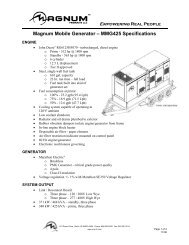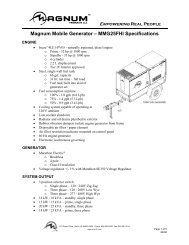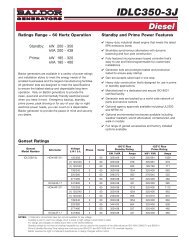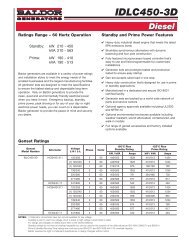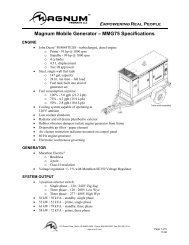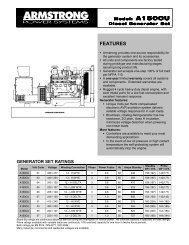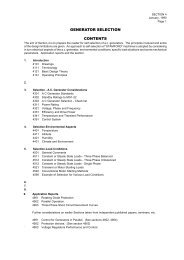GENERATOR SELECTION CONTENTS - Diesel Generator
GENERATOR SELECTION CONTENTS - Diesel Generator
GENERATOR SELECTION CONTENTS - Diesel Generator
Create successful ePaper yourself
Turn your PDF publications into a flip-book with our unique Google optimized e-Paper software.
General<br />
BASIC DESIGN THEORY<br />
SECTION 4121<br />
January, 1990<br />
Page 1<br />
One of the simplest ways to remember how every a.c. generator works is to imagine a magnet and a piece of wire.<br />
Move one of them with respect to the other, whilst keeping them close together, and a measurable voltage will be<br />
induced at the ends of the wire.<br />
Immediately then we see that all a.c. generators must have the following, before an output voltage can be generated:-<br />
a) a magnet - to produce the magnetic field excitation.<br />
b) a piece of wire - usually coils of copper wire.<br />
c) relative movement between these tow - usually a constant rotational speed.<br />
Theory<br />
In its simplest form an a.c. generator is diagrammatcially shown in figure 1. All three criteria stated above are met and<br />
a voltage output will be produced. In this case the magnetic field produced is at a constant level from a permanent<br />
magnet. This type of machine does have practical applications, particularly when supplying a constant load; for<br />
example, a pedal bicycle dynamo.<br />
Figure 1<br />
There are two conditions to consider at this point, the no load condition and the on load condition. The no load output<br />
voltage level is sustained by the constant magnetic field strength produced and fixed by the permanent magnet. On<br />
load, current is drawn from the machine which will cause the output voltage to fall, since the permanent magnet<br />
cannot produce a change in the magnetic field strength. The typical relationship between the output voltage and the<br />
load current is shown in the graph in figure 1. Typically the relationship is nearly linear between no load voltage (V) at<br />
zero current and the short circuit current (Isc) at zero voltage. In order to maintain the output voltage whilst supplying<br />
current, the magnetic field strength must be increased as load is applied. It is this requirement that brings us to the<br />
next stage of a.c. generator design incorporating the electrically produced magnetic field system. (Figure 2).



